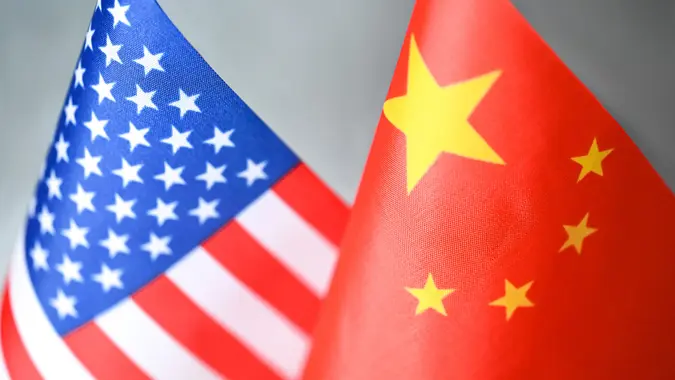5 Countries the US Imports Most From — and How That Could Change With Trump’s Tariff Plan

Commitment to Our Readers
GOBankingRates' editorial team is committed to bringing you unbiased reviews and information. We use data-driven methodologies to evaluate financial products and services - our reviews and ratings are not influenced by advertisers. You can read more about our editorial guidelines and our products and services review methodology.

20 Years
Helping You Live Richer

Reviewed
by Experts

Trusted by
Millions of Readers
As of the latest published news, President Donald Trump still plans to tax imports coming in from the largest providers of goods to the United States. There are many problems with this tariff plan, and it’s worth noting that the relationship between the U.S. and these major import countries is directly related to our exchanges of goods.
Trump has long been a proponent of taxing imports as high as 10% or 20% in the interest of “making America great again.” The thinking, he says, has always been to make the cost of buying goods from other countries so high that U.S. citizens are better served by buying those same goods from American companies.
Now, Trump has announced a plan to raise tariffs on Mexico and Canada by an additional 25% if they don’t get their immigration and drug cartel issues under control.
For insight, we turned to an expert, Andrew Lokenauth, founder of The Finance Newsletter. He says we might see the changes with our largest importers under Trump’s tariff plan.
1. China
As our biggest importer, everyone is looking at what might happen with China. Especially because relations with the country on a political level have long been uneasy, and now, things may get even hairier.
As Lokenauth said, “I think we’ll see a huge drop in imports, and many Chinese goods could get way more expensive… like phones and computers.”
Remember, the costs of increased tariffs will likely not be absorbed by countries like China. Instead, they’ll pass those taxes onto the consumer by raising prices. This rise is predictable, of course, and part of the plan to encourage American consumers to buy their phones and computers from American companies.
Lokenauth also said, “Some manufacturing might move to other Asian countries, like Vietnam or Thailand.” Apparently, the hope is that the cost of production will be lower there and that those countries may escape Trump’s new tariff laws.
2. Mexico
America’s second biggest importer of goods is Mexico. No surprises there. Since the signing of the North American Free Trade Act, or NAFTA, Mexico, the U.S. and Canada have traded openly, which has been largely beneficial to American consumers.
“The whole NAFTA thing could get turned upside down,” Lokenauth stated.
Essentially, the tariff on imports plus the 25% penalty could effectively put an end to NAFTA, making “auto parts and electronics from Mexico pricier.” Plus, he added, “Companies might move some production back to the U.S.”
As it is now, many American manufacturing companies have benefited from crossing the Mexican border to open plants and run businesses, where they can capitalize on cheap labor and pass some of those savings on to the U.S. consumer.
3. Canada
Canada is the third-largest importer of goods into the United States, and, interestingly, the country seemed to have thought itself immune from these tariffs. When the tariffs were first announced, Canada supported Trump’s plan until leaders learned they, too, would be held responsible for a strong border plan.
To date, “Canada has not received an assurance it can avoid Trump’s tariffs, despite presenting a border plan,” according to CTV News.
U.S. consumers save money on oil, pharmaceuticals, vehicles, car parts and machinery from Canada. The prices of those items will no doubt rise if the tariffs hold.
4. Japan
Like other importing countries, Japan, the fourth-largest importer to the United States, provides consumers with low-priced machinery, metals, vehicles, plastics and chemicals. With these raw goods, U.S. companies can produce lower-priced items for consumers.
Japanese corporations rely heavily on their imports to the United States and could lose a lot of money under Trump’s tariffs. Earlier this month, NHK World reported that Japan is “hoping to avoid tariffs by carefully explaining Japan’s record as a responsible investor in the U.S. economy.”
5. Germany
The fifth-largest importer of goods to the United States is Germany, along with many other European countries trailing closely behind. Trump’s tariffs could greatly impact the ongoing relationships between the U.S. and Europe.
“European luxury goods might cost more (think fancy cars and wines), and trade deals with individual EU countries might replace broader agreements,” Lokenauth said.
In the end, we may see myriad changes in trade and business. “Countries like Vietnam and India could become bigger players, and we might see more imports from Brazil and other South American countries.”
The rise in tariffs will likely encourage other countries to step up their production and manufacturing games and outbid their closest competitors.
Unfortunately, it very well could lead to American consumers paying higher prices no matter exactly how it shakes out. And as Lokenauth pointed out, “Small businesses might struggle the most to adapt.”
More From GOBankingRates
- Nearly 1 in 3 Americans Hit by a Costly Holiday Scam, Norton Survey Shows -- How To Avoid This
- Here's What Retirees Wasted the Most Money On in 2025 -- and How To Avoid It in 2026
- How Middle-Class Earners Are Quietly Becoming Millionaires -- and How You Can, Too
- 6 Safe Accounts Proven to Grow Your Money Up to 13x Faster
 Written by
Written by  Edited by
Edited by 

























